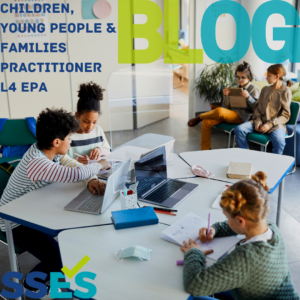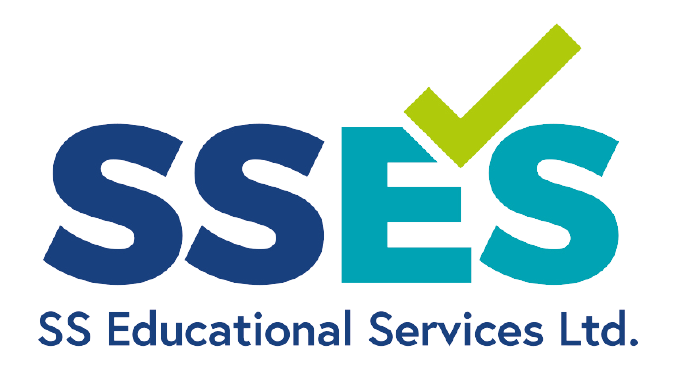During December SS Educational Services looked at the requirements of the End Point Assessment and Gateway for the early years suite of standards. This month we are going to concentrate on the Children, Young People and Families standards. Apprentices can take this qualification as either a level four or level five dependent on the apprentice’s role and previous experience.
For today’s post we are going to concentrate on the Children, Young People and Families Practitioner L4 standard. Within this qualification there two options. Option 1 is for a practitioner in children’s residential care. You could be an apprentice within a children’s home, a residential special school or a secure children’s home. Option 2 is for a children, young people and families practitioner within the community. As an Apprentice you may be working in settings as diverse as family homes, youth centres, children’s centres, educational settings and the community. This is just a small selection of possible opportunities for the Children, Young People and Families Practitioner L4 standard.
Full information on the standard requirements can be found on the Institute for Apprenticeships and Technical Education website. On this post in November we looked at an overview for the standard.
The End Point Assessment for the standard, regardless of whichever option chosen, consists of 2 assessments.
The Apprentice will be visited by an Independent End Point Assessor at their usual place of work. The visit will consist of an observation of practice, followed by a competence interview based on the submitted portfolio. The dates and expectations of the visit will be agreed at least three weeks ahead of the proposed EPA.
1. Observation of Practice
The observation will in total take between 80 and 90 minutes. This includes:
* A 10-minute initial briefing to give the Apprentice the opportunity to outline context of the work they are about to be observed on;
* The observation should take between 55 to 60 minutes;
* The observation will consist of a life setting practical example. The practical example chosen must show that the needs of a specific child or young person is at the centre of this work. The IEPA would expect to see the Apprentice demonstrate the necessary skills and behaviours to carry out this observation;
* This is graded as a pass, fail or distinction.
2. The Competence Interview
The Observation of Practice is then followed up by the Competency Interview after a short break. Ahead of this interview the IEPA will have had an opportunity to review the Apprentice’s portfolio. The interview gives the Apprentice the opportunity to discuss their portfolio in detail to confirm to the IEPA that the work is their own, and no plagiarism has been solved. The IEPA will see evidence of the strengths demonstrated within the portfolio; as well as any gaps or weaknesses in their knowledge, skills or behaviours. Through questioning the Apprentice is given the opportunity to plug the gaps and expand on their strengths.
This is graded as a fail, pass, distinction
We work with Independent End Point Assessors who understands the importance of ensuring the Apprentice is relaxed and prepared during the interview. The Apprentice is encouraged to look at this EPA as an opportunity to showcase the knowledge, skills and behaviours they have learnt during their training.
For today’s post we are going to concentrate on the Children, Young People and Families Practitioner L4 standard. Within this qualification there two options. Option 1 is for a practitioner in children’s residential care. You could be an apprentice within a children’s home, a residential special school or a secure children’s home. Option 2 is for a children, young people and families practitioner within the community. As an Apprentice you may be working in settings as diverse as family homes, youth centres, children’s centres, educational settings and the community. This is just a small selection of possible opportunities for the Children, Young People and Families Practitioner L4 standard.
Full information on the standard requirements can be found on the Institute for Apprenticeships and Technical Education website. On this post in November we looked at an overview for the standard.
The End Point Assessment for the standard, regardless of whichever option chosen, consists of 2 assessments.
The Apprentice will be visited by an Independent End Point Assessor at their usual place of work. The visit will consist of an observation of practice, followed by a competence interview based on the submitted portfolio. The dates and expectations of the visit will be agreed at least three weeks ahead of the proposed EPA.
1. Observation of Practice
The observation will in total take between 80 and 90 minutes. This includes:
* A 10-minute initial briefing to give the Apprentice the opportunity to outline context of the work they are about to be observed on;
* The observation should take between 55 to 60 minutes;
* The observation will consist of a life setting practical example. The practical example chosen must show that the needs of a specific child or young person is at the centre of this work. The IEPA would expect to see the Apprentice demonstrate the necessary skills and behaviours to carry out this observation;
* This is graded as a pass, fail or distinction.
2. The Competence Interview
The Observation of Practice is then followed up by the Competency Interview after a short break. Ahead of this interview the IEPA will have had an opportunity to review the Apprentice’s portfolio. The interview gives the Apprentice the opportunity to discuss their portfolio in detail to confirm to the IEPA that the work is their own, and no plagiarism has been solved. The IEPA will see evidence of the strengths demonstrated within the portfolio; as well as any gaps or weaknesses in their knowledge, skills or behaviours. Through questioning the Apprentice is given the opportunity to plug the gaps and expand on their strengths.
This is graded as a fail, pass, distinction
We work with Independent End Point Assessors who understands the importance of ensuring the Apprentice is relaxed and prepared during the interview. The Apprentice is encouraged to look at this EPA as an opportunity to showcase the knowledge, skills and behaviours they have learnt during their training.


